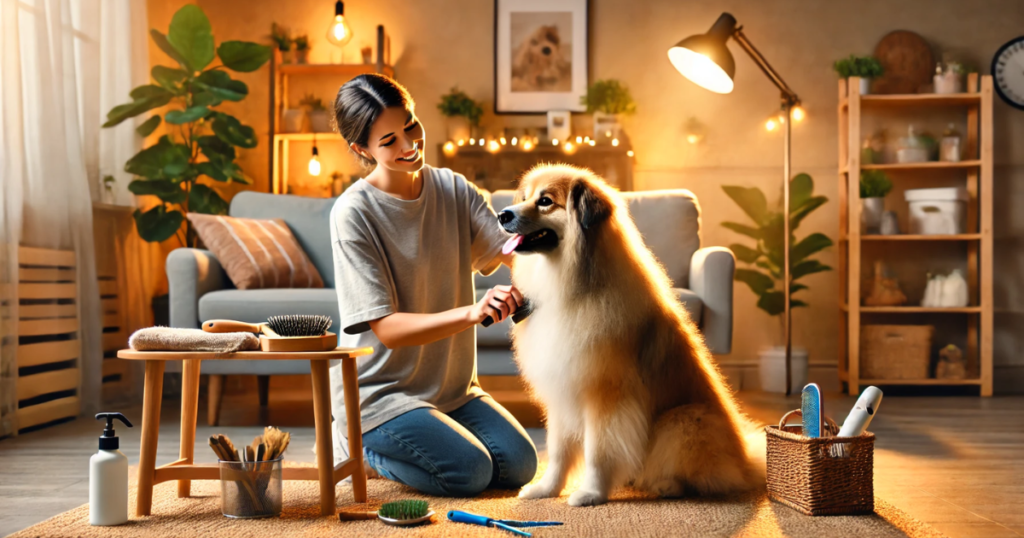
Grooming your dog at home can be a rewarding experience for both you and your furry friend. Not only does it help maintain your dog’s hygiene, but it also strengthens the bond between you two. In this guide, we’ll walk you through the steps of grooming your dog at home, essential tools and products you’ll need, and common mistakes to avoid with the right dog grooming techniques. With a little patience and the right approach, grooming can become a pleasant routine for both of you.
Why Grooming Your Dog at Home is Important
Grooming isn’t just about keeping your dog looking good. It plays a crucial role in their overall health and well-being. Regular grooming can prevent skin issues, reduce shedding, and even help you spot potential health problems early on. For instance, consistent brushing can distribute natural oils throughout your dog’s coat, ensuring it stays shiny and healthy.
Moreover, grooming sessions provide an opportunity for you to check for any abnormalities such as lumps, bumps, or parasites. This early detection can lead to prompt treatment and prevent more serious health issues down the line. Additionally, a well-groomed dog is less likely to develop matting, which can be painful and lead to skin infections.
Essential Tools and Products to Groom a Dog at Home
Before you get started, you’ll need to gather some essential tools and products. Here’s a list of what you’ll need:
Brushes and Combs
Different breeds have different coat types, so you’ll need to choose the right brush or comb for your dog. Slicker brushes are great for removing tangles, while bristle brushes are ideal for short-haired breeds. Pin brushes work well for dogs with longer hair, and undercoat rakes are perfect for breeds with thick undercoats.
For dogs with curly or wavy fur, a comb with wide-spaced teeth can help detangle without causing pain. Remember to brush your dog regularly to prevent mats and tangles, which can be uncomfortable and lead to skin issues.

Nail Clippers
Keeping your dog’s nails trimmed is crucial to prevent discomfort and potential injuries. Invest in a good pair of dog nail clippers and a styptic powder in case you accidentally cut too close to the quick. There are several types of nail clippers available, including guillotine-style and scissor-style; choose the one you feel most comfortable using.
If your dog is particularly anxious about nail trimming, consider using a nail grinder. These devices can file down the nails slowly and gently, reducing the risk of cutting too close to the quick.

Shampoo and Conditioner
Use a dog-specific shampoo and conditioner to keep your dog’s coat clean and healthy. Human products can be too harsh for their skin. Look for shampoos that cater to your dog’s specific needs, whether they have sensitive skin, a specific skin condition, or require flea and tick protection.
Conditioners can help keep your dog’s coat soft and tangle-free. Make sure to thoroughly rinse out all products to avoid any residue that could irritate your dog’s skin.

Ear Cleaner
Dogs are prone to ear infections, so it’s important to keep their ears clean. Use a vet-approved ear cleaner to gently clean their ears. Regular ear cleaning can help prevent infections and remove any debris or wax buildup.
Be sure to follow the instructions on the ear cleaner and never insert anything deep into the ear canal, as this can cause injury. Regular ear checks can help you notice any signs of infection early, such as redness, odor, or excessive scratching.
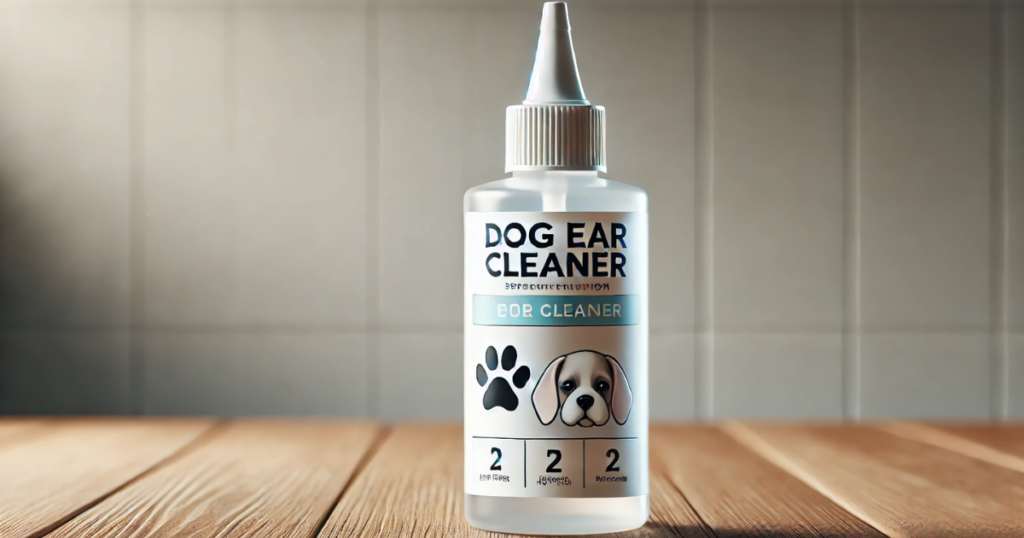
Towels and Blow Dryer
Have plenty of towels on hand to dry your dog after a bath. A blow dryer on a low setting can help speed up the drying process, especially for long-haired breeds. Make sure to use a pet-specific blow dryer, as human hair dryers can get too hot for dogs.
Pat your dog dry with towels first to remove as much water as possible before using the blow dryer. This can help prevent your dog from getting chilled and reduce the time needed to dry their coat completely.

Step-by-Step Guide to Grooming Your Dog at Home
Now that you have all the essential tools and products, let’s dive into the step-by-step process of grooming your dog at home.
1. Brushing
Start by brushing your dog’s coat to remove any tangles or mats. This will make the bathing process easier and more effective. Regular brushing helps to distribute natural oils, keeping the coat shiny and healthy. For dogs with long hair, make sure to section the coat and brush thoroughly to avoid any missed tangles.
Brushing also helps to remove loose fur, which can reduce shedding around your home. Make it a relaxing experience by speaking softly and giving your dog treats or breaks if needed.

2. Bathing
Fill a tub with lukewarm water and wet your dog’s coat thoroughly. Apply a small amount of dog shampoo and lather it up, starting from the neck and working your way down. Be sure to avoid their eyes, ears, and nose. Rinse thoroughly to remove all the soap.
If your dog has a thick or double coat, you might need to rinse a few times to ensure all shampoo is removed. Leaving shampoo residue can cause skin irritation.
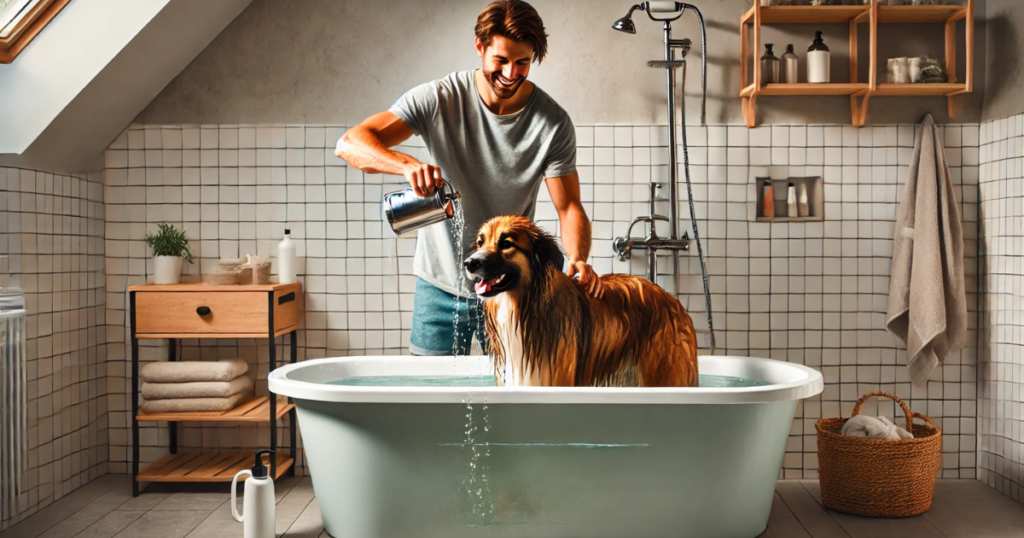
3. Conditioning
Apply a dog-specific conditioner to your dog’s coat and let it sit for a few minutes. This step is crucial for dogs with long or curly hair to prevent tangles and keep the coat manageable. Rinse thoroughly to remove all the conditioner.
Conditioning helps to restore moisture to the coat and skin, making it softer and easier to brush. Make sure to choose a conditioner suited to your dog’s coat type.

4. Drying
Use towels to gently pat your dog dry. If you have a blow dryer, use it on a low setting to dry their coat completely. Be careful not to use too high a heat setting, as this can burn your dog’s skin.
Drying thoroughly is important to prevent your dog from getting chilled, especially in colder weather. For dogs with thick coats, ensure that the undercoat is completely dry to avoid any dampness that could lead to skin issues.

5. Nail Trimming
Carefully trim your dog’s nails, being cautious not to cut too close to the quick. If you’re unsure, it’s better to trim a little at a time. Overgrown nails can cause discomfort and affect your dog’s walking posture.
If your dog has dark nails and it’s hard to see the quick, trim very small amounts at a time and check the cut surface for a black dot, which indicates you’re near the quick. Reward your dog with treats and praise to create a positive association.
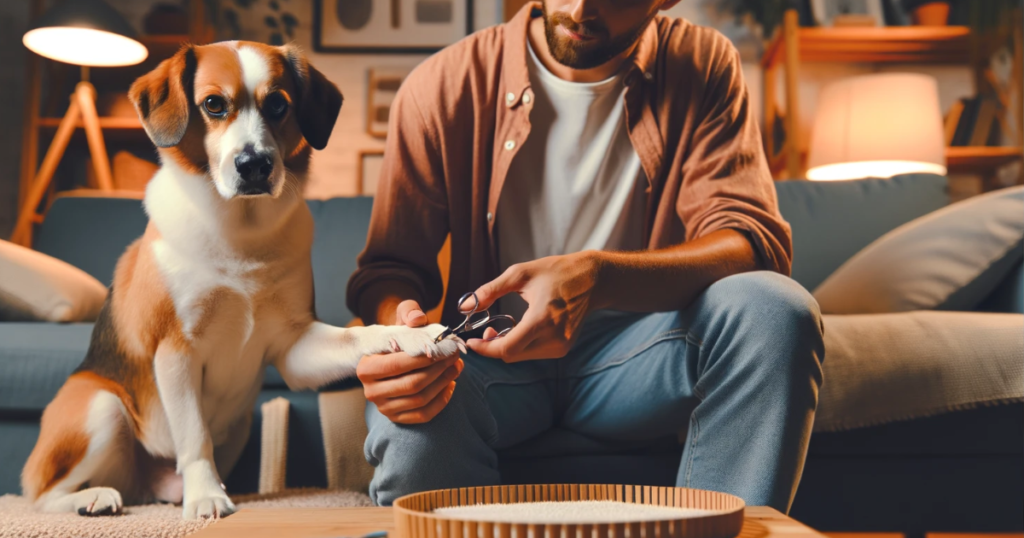
6. Ear Cleaning
Use a vet-approved ear cleaner to clean your dog’s ears. Apply a few drops into their ear canal, massage the base of their ear, and then wipe away any debris with a cotton ball. Regular ear cleaning helps prevent infections and keeps your dog comfortable.
Avoid using cotton swabs inside the ear canal, as this can push debris further in and cause injury. Regular checks can help you notice any signs of infection early.
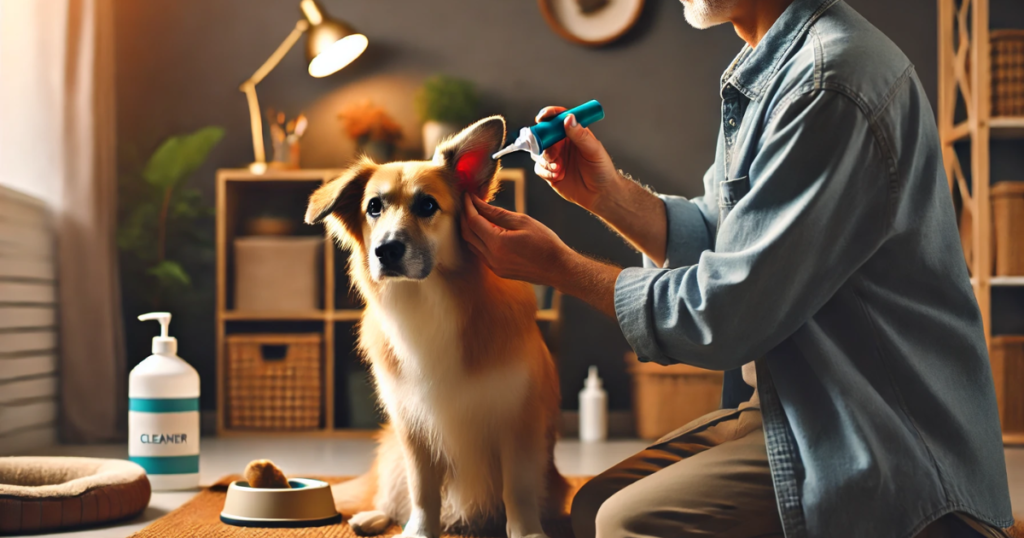
7. Finishing Touches
Give your dog a final brush to remove any loose hair and make their coat look shiny and smooth. This is also a good time to check for any missed tangles or mats and to ensure that your dog’s coat is completely dry.
Take a moment to inspect your dog’s overall appearance and make any necessary adjustments. Reward your dog with a treat and plenty of praise to end the grooming session on a positive note.

Common Mistakes to Avoid When You Groom a Dog at Home
Grooming your dog at home can be a bit tricky, especially if you’re new to it. Here are some common mistakes to avoid:
Using Human Products
Human shampoos and conditioners can be too harsh for your dog’s skin and may cause irritation. Always use products specifically designed for dogs. Human products can disrupt the pH balance of your dog’s skin, leading to dryness and potential skin problems.
Additionally, some ingredients in human products can be toxic to dogs. Always read labels and consult your vet if you’re unsure about a product.

Skipping Regular Grooming
Consistency is key when it comes to grooming. Skipping regular grooming sessions can lead to matting, skin issues, and other problems. Establish a grooming routine that suits your dog’s coat type and stick to it.
Regular grooming also helps your dog get used to the process, making each session easier and more enjoyable. It helps to prevent the buildup of dirt and debris, which can cause skin irritations.
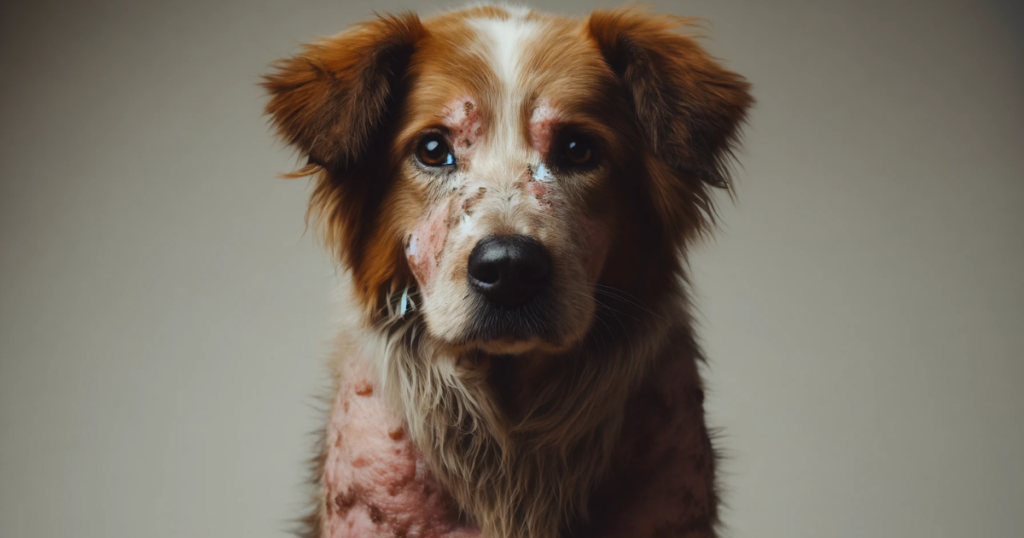
Being Too Rough
Always be gentle when grooming your dog. Being too rough can cause discomfort and make the experience unpleasant for your dog. Gentle handling helps to build trust and makes grooming a positive experience.
If your dog is anxious or resistant, take breaks and offer treats to make the process more enjoyable. Patience and a calm demeanor go a long way in ensuring a smooth grooming session.
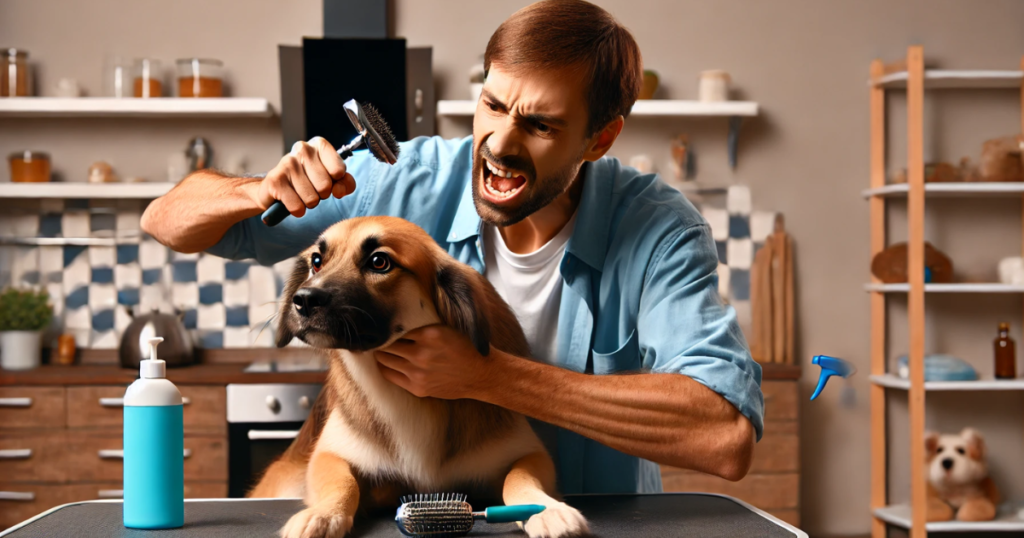
Neglecting the Ears
Ignoring your dog’s ears can lead to infections. Make ear cleaning a regular part of your grooming routine. Ear infections can be painful and may lead to more serious health issues if left untreated.
Regular ear checks and cleaning help to prevent buildup of wax and debris, which can cause discomfort and infection. Keep an eye out for any signs of problems, such as redness, swelling, or foul odor.
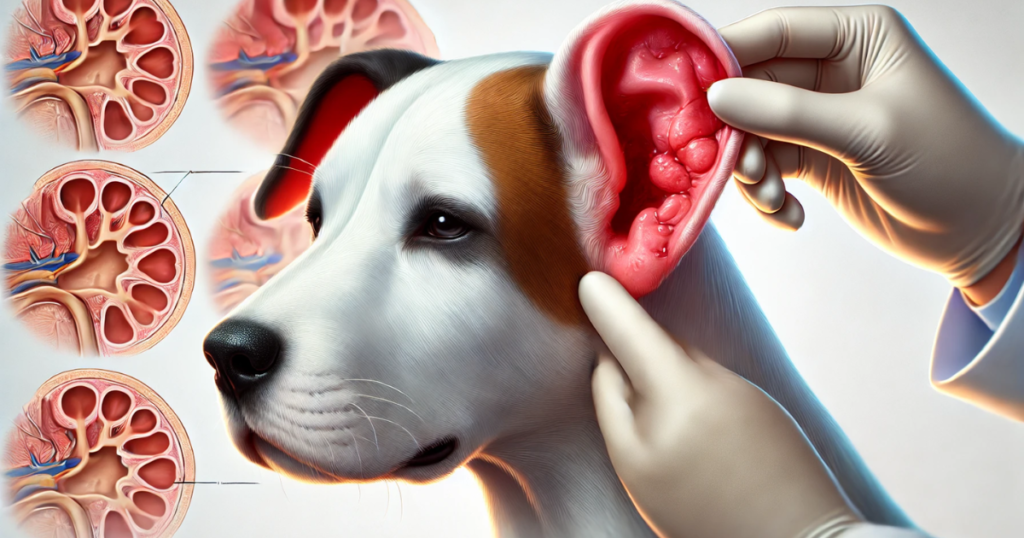
Cutting Nails Too Short
Cutting your dog’s nails too short can cause pain and bleeding. Trim a little at a time and use a styptic powder if needed. If you’re unsure, consult a vet or professional groomer for guidance on proper nail trimming techniques.
Frequent, small trims are better than infrequent, large cuts. This approach minimizes the risk of cutting the quick and helps to keep your dog’s nails at a healthy length.

Benefits of Grooming Your Dog at Home
Grooming your dog at home offers several benefits:
Cost Savings
Professional grooming services can be expensive. Grooming your dog at home can save you money in the long run. While there is an initial investment in tools and products, these are one-time costs that quickly pay for themselves.
Additionally, home grooming allows you to groom as often as needed without worrying about the costs of professional services. This can be particularly beneficial for breeds that require frequent grooming.

Bonding Time
Grooming your dog provides an excellent opportunity for bonding. It helps build trust and strengthens your relationship. Regular grooming sessions can become a special time for you and your dog to connect.
This one-on-one time allows you to better understand your dog’s needs and preferences. It also helps your dog feel more comfortable and secure with you, enhancing your overall relationship.
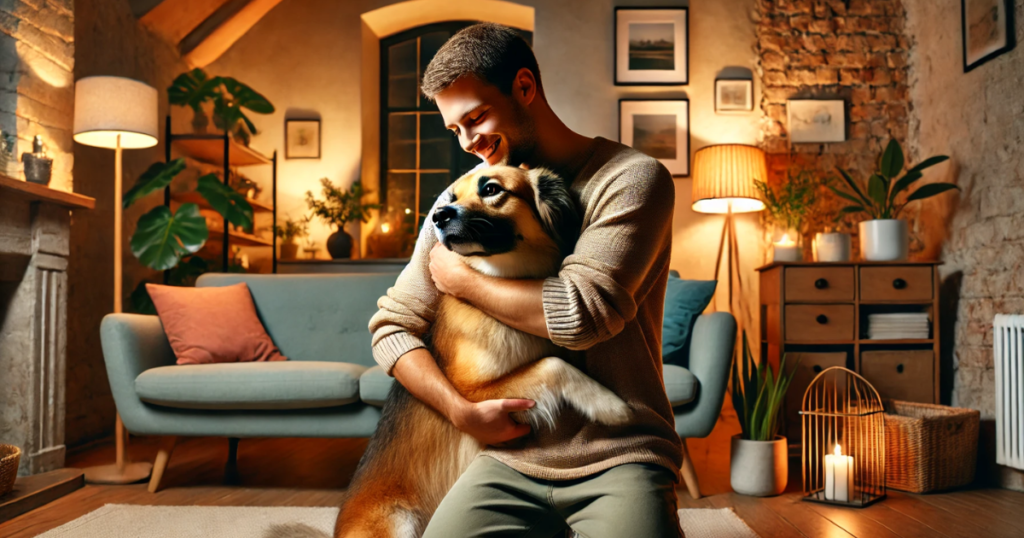
Early Detection of Health Issues
Regular grooming allows you to check for any unusual lumps, bumps, or skin issues that may require veterinary attention. Early detection of health issues can lead to prompt treatment and prevent more serious problems.
By being hands-on with your dog, you become more familiar with their body and can quickly notice any changes. This proactive approach to your dog’s health can significantly improve their well-being.
Conclusion
Grooming your dog at home can be a rewarding and cost-effective way to keep your furry friend looking and feeling their best. By following the steps and tips outlined in this guide, you’ll be well on your way to becoming a pro at dog grooming. Remember, consistency is key, and always use the right tools and products to ensure your dog’s comfort and health.
By taking the time to groom your dog regularly, you’ll not only improve their hygiene but also strengthen the bond between you and your beloved pet. Happy grooming!
